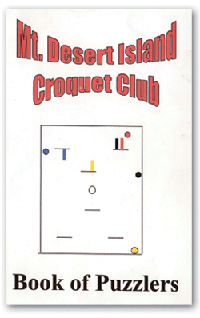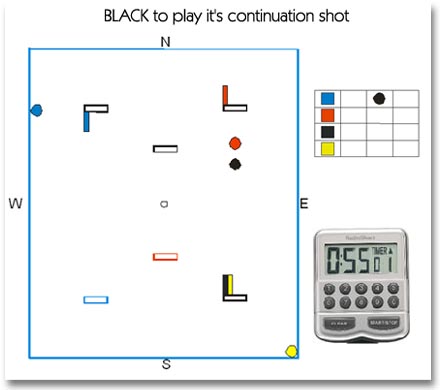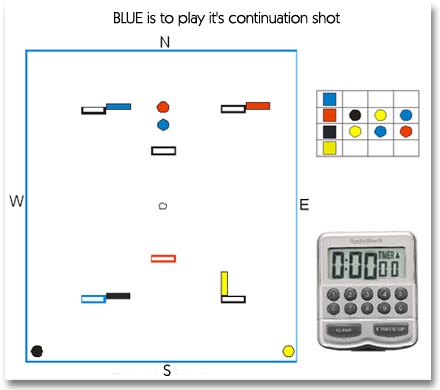
|
Back to |
| The Front Page |
| The Game |
|
"The Book of Puzzlers" - a casebook of American Rules strategy |
||||||||||
|
Bob Alman reviews Larry Stettner's new book; Illustrations and photos by Larry Stettner Posted December 24, 2007
|
||||||||||
|
||||||||||
Larry Stettner has played out his love affair with American Rules croquet for two decades as a frequent fixture in major competitions - first in second flight, then first flight, and finally the championship flight. His mastery of American Rules strategy - including the risk-versus-gain calculations essential to success in American Rules at any level - compensates substantially for less-than-perfect strokes. American Rules players at all levels will appreciate this entertaining book. For Association players interested in learning the intricacies of American Rules, taking on 50 puzzles will give them the benefit of many hard lessons they might otherwise have to learn on the court as victims of a more thoughtful opponent mercilessly keeping them three-ball dead until the clock runs out. Imagine yourself in two of the situations from the book, presented below in full. Then, if you can, think your way out of them. If you can't, enlighten yourself by studying the answer(s) on the facing page.
The members of Maine's Mount Desert Island Croquet Club who don't fly south for the winter found a way to keep the croquet club alive during the winter of 2005-06, and not by playing the game on frozen ground. Instead, they worked on solving American Rules croquet puzzlers - situations in real games that present the player with no obvious or clear way forward to a happy resolution for that player's side, but which, on closer examination, can often be understood in a flash of blazing clarity that tells you the one best play to make in that situation.
|
|
|
The blog on the new Croquet Professionals website at http://www.croquetprofessionals.com/ includes not only complete charts of the situations described, but also streaming illustrations of the actions described and comments from readers.
|

|
| The author is ball-in-hand with a blue ball not nearly as blue as his lupine on a balmy June day on the Mount Desert Island court at his home. Clearly, he hasn't decided yet what he should next. |
And just to make the exploration richer, as Stettner points out in the preface, "In croquet as in life, there is not always just one right answer, and in many cases the pros and cons of different choices are discussed and elaborated. We hope you will not only try to solve these puzzlers for yourself, but discuss them with other players as well. The dialogue is half the fun."
Yes, the book IS fun, but it's practical fun, it's educational fun, if you want to improve your American Rules game. Stettner reminds us that another attribute of American rules play is THE CLOCK. As these puzzlers show, 45 seconds is often not nearly enough time to find the right answer - the answer you'll think of in the middle of the night after you threw away a match with an ill-considered move under pressure of time after the 15-second call. You'll curse yourself and you'll say, "I'll never make THAT mistake again."

And you may be right. But Stettner reminds you in this book that you don't have to make all those agonizing mistakes, not even once. His puzzlers put you into those situations with plenty of time to figure them out and apply them to similar situations in your own future games.
Here's another big plus for a small-run publication: It has been thoroughly "market tested" by friends and fellow players at the Mount Desert Island Croquet Club, who "discovered" many of the situations and who, most importantly, speculated and commented on the answers to help refine and clarify the presentation throughout.
To make the book even more self-contained and easy to use, Stettner has included separate indexes for each of the two Puzzler sections, a glossary of croquet terms, a summary of the rules of play, and a guide to the order of running the wickets.

|
How many times have you been trapped at courtside or worse yet, at the bar, by someone who insists on telling you everything about a game situation in one sitting, when you'd much rather talk about religion or politics or who's sleeping with whom? Not because the game situation isn't interesting, but because you have to know so much about so many elements of the game before you can even begin to evaluate the correct strategy. It's hard to keep it all in mind, all at once - more difficult even than trying to keep deadness and the wicket positions in your head. Stettner's book gives you all that information at a glance in the right-hand column of every Puzzler: a complete court diagram showing the precise position of the balls, where the clips are, the deadness board, and the time remaining on the clock.
After Stettner's book, you may never again be willing to tolerate the unorganized, uncalibrated post-game analysis at the bar. You'll have to talk about something else, and your life will be the richer for it!
About the two Puzzlers below and their solutions
We can't do them full justice because we can't show in one display the complete game diagram and the narrative description of the situation on one screen. So we have to stack these elements, with the game chart given first, followed by the narrative Puzzler, and you're going to have to scroll back and forth. The third part is, of course, the answer.
The two Puzzlers are from the two distinct sections of the book, each with 25 Puzzlers: the "Basic Puzzlers," for the Intermediate level player; and the "Advanced Puzzlers" for everyone else. Advanced players will find that all the Puzzlers are entertaining to review, because everyone encounters the same situations, and the advance player may very well have a different solution from the one given in the "basic" section, based on superior shot-making skill at a higher level of play. By the same token, the novice can get a head start on advanced strategy while he or she improves the strokes necessary to play at a higher level.
Prologue: It was about 20 minutes into the game on a sparkling bright spring day in Maine. It was black's turn, as it was sitting on the N boundary behind wicket two, for wicket three. Red was for wicket three, set up three feet in front of the wicket and alive on everything. Yellow was for wicket four, in the SE corner behind wicket four, and had no deadness. Black's partner blue was for wicket two and was sitting on the W boundary to the side of its wicket, dead only on partner. Black, being dead on blue and knowing that blue was dead on it as well, decided to shoot at red. Black figured that if it missed it would be safely out of bounds. Lo and behold, black hit red, just skinning it. Then black splits red, makes wicket three but goes a little past red after running the hoop and has no rush to wicket four.
The situation facing black now is: Blue is still on the W boundary to the side of wicket two, is for wicket two and is dead only on black. Red is about 10 feet S of wicket three on a line between wickets three and four, for wicket three and alive on all balls. Black is about 12 feet S of wicket three, just in front of red, for wicket four and now alive on all balls. Yellow still sits in the SE corner behind wicket four, for wicket four, and is three-ball live as well. What should black do?

|
Answer to Puzzler # 1
Black should roquet red gently and then send it over to blue, between blue and wicket two, so that blue has a rush to the hoop and thus can easily make its wicket after it roquets red. Then, black goes and sets up right in front of wicket three, as a pioneer for partner blue to use after blue makes wicket two.
Now partner ball blue is in very good shape to make its wicket, thus also clearing its partner deadness, and further to make at least one more wicket as well. It simply roquets red over to hoop two, splits red, makes the hoop, roquets red again and then takes off to black at wicket three, and makes that hoop as well.(If blue is skilled enough, it has a three-ball break of course once it comes through wicket two. We generally advise the more conservative play of a simple take-off this early in the game when running a break would involve a long and somewhat difficult split, such as splitting a ball from two up to four while getting striker ball over to a pioneer at three.)
With this sequence of plays your partner has totally cleared its deadness, and your team has made two additional hoops, all with relatively easy shots. Both your balls are alive on partner and the opponents could not join up, nor make a hoop, and thus have accomplished nothing. A very good result for your side, with a very high probability of it being accomplished.
If on the other hand you (black) had roqueted red and tried to make your wicket at four, then: a) this has a very low probability of success because you will be very far away from wicket four after roqueting red, b) even if you manage to make a great shot and take off to position and make your hoop at four you will have made only one wicket and blue will still be dead on partner. So, even success with this play is not really that successful! Furthermore, failure could be disastrous. If you end up with a pretty good wicket shot and miss it, then you are on the court near yellow's hoop where it might well be able to hit you and make its hoop. Potentially even worse, since you will have left red near its hoop at three, with blue far away, yellow could go between red and its wicket, and thus give red a three-ball break, with you, black, having furnished a nice pioneer for the opponents. So, to emphasize the point once more, black roqueting red and then trying to make its wicket is a bad play at best it is a mediocre result and at worst it is a disaster.
The moral of this story is simple and represents one of the most powerful principles of the American rules game: When partner is dead on you and you are live on it and have the spent ball close by, send the spent ball to partner so that it can make its hoop and get clean. Thus you gain a hoop for your side, clean your partner and retain your aliveness on partner as well.
In fact, even if the situation in puzzler one was such that black had a perfect rush on red to hoop four after coming through three, it would be unwise to take it at this point in the game. Why would black give up an apparently easy hoop? A bad rush, always a possibility, would leave you in worse position to feed red to blue-black had a perfect angle to send red over to blue, with a large margin of error, since it was shooting red along a line between blue and wicket two, and could stop just about anywhere between blue and the hoop to give blue a good shot. In shooting red to blue from an angle closer to four, there is a much greater chance that a too weak or too strong shot could leave blue only a mediocre rush or no rush at all to its hoop.
A good rush would probably give black a hoop, it is true, but then black would have to roquet red again, and feed red to blue all the way from four over to two, a much more difficult shot than it had initially from near three if it had just tapped red and sent it over to blue immediately. Since getting blue clean is paramount at this point in the game, it is unwise to try anything that would make that more difficult. And, of course, there is always the risk that you miss the wicket shot after all. Why even take this chance? There is absolutely no point in blowing a great opportunity to get partner alive and in the process have it make at least two hoops, in order for you to make just one hoop!
This was a situation faced by the MDI club puzzle master himself, me, many years ago while playing at the Breakers Hotel in Palm Beach. I lost a game that I should have won easily, because I did not think of the correct play until the next day. You, dear reader, having had the wisdom and foresight to have purchased this book, will have the advantage of learning what to do in this type of situation right now, before you encounter it on the court and thus will win your game when it happens.
Blue, now first ball in last turns, has just come through wicket six after roqueting red and using it to make the hoop. Black is for two-back, is in the SW corner behind two-back and is triple dead. Yellow, which will be last ball in last turns, is for wicket four, is in the SE corner behind four, and is triple live. Red is for four-back, is triple dead and is sitting 9 1/2 feet behind wicket six, where it was sent by blue on blue's croquet shot before blue made the hoop. Blue came straight through the wicket to a spot about 1 1/2 feet south of red, where the only rush it has is toward the N boundary, unless it pulls off a quite amazing cut rush, practically defying Newtonian physics. The score at that moment is blue-black 13, and red-yellow 12. Blue thinks: "Hmm, I am up one hoop but the odds of me making another hoop on this turn are pretty slim and the odds of making more than one more hoop are practically nil. Making it worse, black is three-ball dead and of no use and with yellow near its hoop and live on everything, red can set it a rush and yellow will tie or win the game on its turn if I don't think of something!"
As noted above in that situation I did not think of anything that worked. Can you help blue to win the game?
Summing up: Blue is 8 feet straight north of 6, for one-back, live on all balls, first ball in last turns. Red is 1 1/2 feet due north of blue, for four-back and triple dead. Black is in the SW corner behind two-back, for two-back and triple dead also. Yellow is in the SE corner behind four, for four, triple live. It is blue to play its continuation shot.

|
Answer to Advanced Puzzler # 4
The answer to this is so simple that the key element in it does not even require blue to shoot! Blue simply taps red, then with ball in hand places its ball in contact with red in such a position that blue is on a direct line between red and yellow. "Was blind, but now I see."
Being dead on blue and being three-ball dead and thus not being able to claim a wire, red can only shoot away and can not get anywhere close to yellow. Yellow will at best have a long hit-in shot and if it does hit-in will be far from its hoop, rather than having the cushy rush close to the hoop that it was expecting.
It is good to remember that one can have one's way with an opponent ball that is three-ball dead. It opens up all kinds of diabolical possibilities. How about a game situation where the spent ball is three-ball dead, and you roquet it and your partner is very close by and live on it too? Then you could place your ball on one side of the opponent after your roquet and pass your continuation shot, then your partner could roquet the opponent very gently on its turn and place its ball on the other side of it and then the opponent could not go anywhere!
How to Order "The Book of Puzzlers"
Write to Larry Stettner, 106 Seawall Road, SW Harbor, Me 04679. Include check for $29.55 made payable to Larry Stettner, covering shipping and handling for one copy of the copy, priced at $24.95. (Cost of two copies included S&H is $54.50.) Comments, inquiries, and questions about prices for bulk orders are welcomed by phone at 207-266-2733 or by email at larryorfran@yahoo.com.